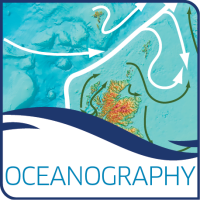Average (mean) physical variables from the FVCOM Scottish Shelf Model (SSM) interpolated to 1.5 x 1.5 km and 7 x 7 km regular grids. The data are averaged over 3x four month periods (MAMJ, JASO, NDJF), and are provided from model runs with and without large scale tidal energy extraction (10x tidal stream arrays, EcoWatt2050) included.
Variables: sea bottom temperature (BT), potential energy anomaly (PEA), and largest 95 percentile of instantaneous depth-averaged current speed (p95).
These data are from a 1 year climatological model run of the SSM (version 2.01) representing 1990-2014.
Naming convention:
MAMJ: March, April, May, June
JASO: July, August, September, October
NDJF: November, December, January, February.
These data were developed under the EcoWatt2050 EPSRC projects (grant numbers EP/J010170/1 & EP/K012851/1 respectively) using the Scottish Shelf Model (http://marine.gov.scot/information/scottish-shelf-model). For more information about EcoWatt2050 please see http://marine.gov.scot/information/EcoWatt2050.
Data and Resources
- SSM_variables_1990-2014_climatology_2.01_1.5km_regular_gridnetCDF
netcdf SSM_variables_1990-2014_climatology_2.01_1.5km_regular_grid {
Download
... - SSM_variables_1990-2014_climatology_2.01_7km_regular_gridnetCDF
netcdf SSM_variables_1990-2014_climatology_2.01_7km_regular_grid {
Download
...
| Field | Value |
|---|---|
| Publisher | |
| Modified | 2020-01-07 |
| Release Date | 2019-05-15 |
| Identifier | 8f2a71fe-3321-47dc-b1c1-c43d0d64b61e |
| Temporal Coverage | 1990-01-01 to 2014-12-31 |
| License | UK Open Government Licence (OGL) |
| Granularity | Average of 4 month periods |
| Data Dictionary | The climatological average boundary forcing for 1990-2014 were derived from Atlantic Margin Model 7 km model output (Edwards et al. 2012, O’Dea 2012). The climatological average atmospheric forcing for 1990-2014 were derived from ERA-Interim data (Dee et al, 2011). The river runoff volume flux climatology for 1962-2011 were obtained from the Centre for Ecology and Hydrology (CEH) Grid-to-Grid (G2G) model (Bell et al. 2007, Cole and Moore 2009). For a full description of these data see De Dominicis et al. (2017). V. Bell, A. Kay, R. Jones, R. Moore, 2007. Development of a high resolution grid-based river flow model for use with regional climate model output, Hydrol. Earth Syst. Sci. 11 (1) 532-549. S.J. Cole, R.J. Moore, 2009. Distributed hydrological modelling using weather radar in gauged and ungauged basins, Adv. Water Resour. 32 (7) 1107-1120. De Dominicis, M., O’Hara Murray, R.B., Wolf, J., 2017. Multi-scale ocean response to a large tidal stream turbine array. Renew. Energy 114, 1160–1179. doi:10.1016/J.RENENE.2017.07.058 D.P. Dee, S.M. Uppala, A.J. Simmons, P. Berrisford, P. Poli, S. Kobayashi, K. Edwards, R. Barciela, M. Butenschon, 2012. Validation of the NEMO-ERSEM operational ecosystem model for the North West European continental shelf, Ocean Sci. 8 983-1000. E. O'Dea, A. Arnold, K. Edwards, R. Furner, P. Hyder, M. Martin, J. Siddorn, D. Storkey, J. While, J. Holt, H. Liu, 2012. An operational ocean forecast system incorporating NEMO and SST data assimilation for the tidally driven European North-West shelf, J. Oper. Oceanogr. 5 (1) 3-17. J. Wolf, N. Yates, A. Brereton, H. Buckland, M. De Dominicis, A. Gallego, R. O’Hara Murray, 2016. The Scottish Shelf Model. Part 1: Shelf-Wide Domain. Scottish Marine and Freshwater Science Vol 7 No 3, 151pp. doi: 10.7489/1692-1 |
| Contact Name | Marine Scotland |
| Contact Email | |
| Public Access Level | Public |


